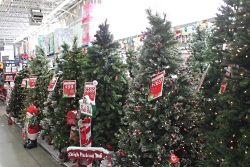
Courtesy & Copyright Ron Hellstern, Photographer
And, not meaning to bring up a point of controversy, some people are starting to wonder about the connection of trees to the Christmas Season.
Christmas trees started as a pagan ritual in many countries where people believed that evergreens would keep away witches, evil spirits, ghosts, and sickness. But Germany is credited with starting the Christmas tree tradition, as we now know it, in the 16th century. Even in the 19th Century most Americans felt that the indoor tree was still a pagan symbol.
Eventually, the tradition was accepted in England and East Coast America when popular Queen Victoria, and her German Prince Albert, were shown standing around a Christmas tree. Soon, trees from floor to ceiling were hauled into homes and decorated with fruits, nuts, popcorn, and homemade ornaments.

Courtesy & Copyright Ron Hellstern Photographer

Courtesy & Copyright Ron Hellstern, Photographer
The best option more people are trying is buying a smaller, live, potted tree that can be planted outdoors. But that can be tricky. Keep the tree indoors for only a few days, then place it outside in its pot, insulate it with mulch, and water it if the soil dries out. Or perhaps there is space near a window inside your garage. Then plant it in late March or early April to enjoy and contribute to the many benefits of trees that were mentioned at the start of this program. Whatever your choice, have a Merry Christmas.
This is Ron Hellstern, and I am Wild About Utah.
Credits:
Images: Courtesy & Copyright Ron Hellstern
Lead Audio: Courtesy and Copyright
Text: Ron Hellstern, Cache Valley Wildlife Association
Additional Reading
Hellstern, Ron, The Hidden Life of Trees, Wild About Utah, August 26, 2019, https://wildaboututah.org/the-hidden-life-of-trees/
Wohlleben, Peter, The Hidden Life of Trees, Jane Billinghurst, Translator, Greystone Books Ltd., 2016, https://www.amazon.com/Hidden-Life-Trees-Illustrated/dp/177164348X
Kuhns, Michael, Utah Grown Christmas Trees, Extension Utah State University, Extension Forestry Specialist, November 4, 2015, https://forestry.usu.edu/forest-products/utah-grown-trees
Sagers, Larry, Using A Living Christmas Tree To Decorate Your Home, KSL, December 3, 2011, https://www.ksl.com/article/18337807/using-a-living-christmas-tree-to-decorate-your-home
